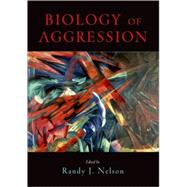Biology Of Aggression
, by Nelson, Randy J.- ISBN: 9780195168761 | 0195168763
- Cover: Hardcover
- Copyright: 8/25/2005
Unchecked aggression and violence take a significant toll on society. Even if we manage to avoid being the direct victim of a violent act, the effects of aggression and violence reach us all: We hear about the mauling of a woman by an aggressive dog, our children are bullied at school, or wedeal with impulsive violence while commuting to work or attending a sporting event. Reflecting psychology in general, the dominant roles of learning and environmental influences - both social and nonsocial - have traditionally been prominent in discussions of the etiology of human aggression.Biological factors have not been considered sufficiently important to investigate in the search for ways of dealing with human aggression or violence. With recent advances in pharmacology and genetic manipulation techniques, however, new interest has developed in the biological mechanisms of bothnon-human and human aggression. Although aggression is certainly a complex social behavior with multiple causes, molecular biological factors should not be overlooked, as they may well lead to interventions that prevent excess aggressive behaviors. The primary goal of this book is to summarize andsynthesize recent advances in the biological study of aggression. As most aggressive encounters among human and non-human animals represent a male proclivity, the research in this book describes and discusses studies using the most appropriate murine model: testosterone-dependent offensiveinter-male aggression, which is typically measured in resident-intruder or isolation-induced aggression tests. The research also emphasizes various molecules that have been linked to aggression tests. The research also emphasizes various molecules that have been linked to aggression by the latestgene-targeting and pharmacological techniques. Although the evidence continues to point to androgens and serotonin (5-HT) as major hormonal and neurotransmitter factors in aggressive behavior, recent work with GABA, dopamine, vasopressin, and other factors, such as nitric oxide, has revealedsignificant interactions with the neural circuitry underlying aggression. This book is organized according to levels of analysis. The first section examines the genetic contributions to aggression in species ranging from crustaceans to humans. The section summarizes the involvement of variousneurotransmitters and neuromodulators in aggressive behavior. The third section summarizes the influence of hormones on aggression, primarily in humans. All chapters emphasize future directions for research on aggression and reveal important domains that have received comparatively less attentionin this literature. Considered together, these chapters provide up-to-date coverage of the biology of aggression by some of the leading authorities currently working in this field. Biology of Aggression will direct future research to continue the recent advances in the pharmacological and geneticapproaches to understanding aggression and violence. It promises to be a valuable resource for professional and student researchers in neuroscience, psychiatry, cognitive and developmental psychology, behavioral biology, and veterinary medicine.







